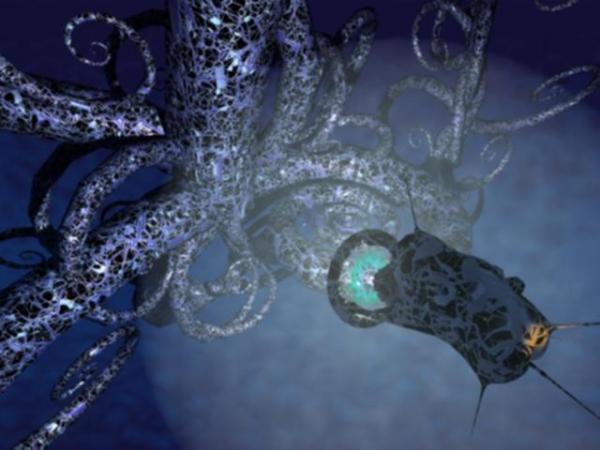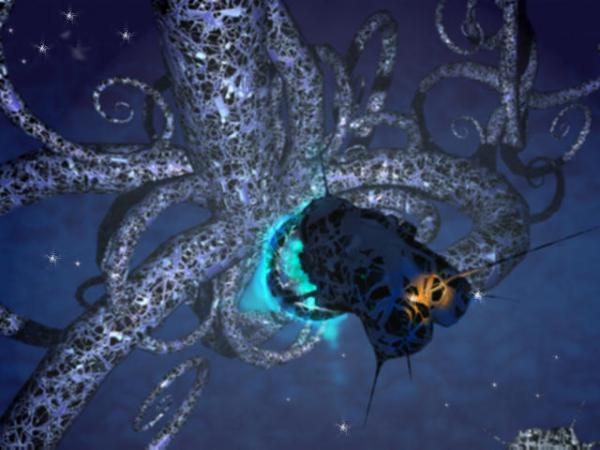BY LETTER
Fractaroni Spaghetti Worms
Galactography > Cybercosm, The
Galactography > Sephirotic Empires > Mutual Progress Association
Sophonts > Modosophonts > Neogen
Sophonts > Modosophonts > Parasapient A-life
Galactography > Sephirotic Empires > Technorapture Hypernation
Sophonts > Transapients
Galactography > Sephirotic Empires > Mutual Progress Association
Sophonts > Modosophonts > Neogen
Sophonts > Modosophonts > Parasapient A-life
Galactography > Sephirotic Empires > Technorapture Hypernation
Sophonts > Transapients
Transapient clade of a-life/neogen hybrids |
 Image from Juan Ochoa |
Created in a 4 dimension+time virtual simulation developed by the TRHN, the Fractaroni tubeworms are the dominant lifeform and largest structure in their cybercosm. Individuals can be up to tens of millions of km long, branch fractally, and vary in height, width, length and wugth from microscopic to tens of kilometres. Wugth is a neologism denoting the fourth spatial dimension in such worlds.
The worms emerged via a self-evolving program to become sophont beings, but they were unaware at first that they existed inside an artificial environment.
In their original environment, large worms are usually found wrapped around the white hole energy sources which are the equivalent of stars in this artificial cosmos. The largest parts of these creatures are hollow and contain complete ecologies of lesser creatures. Fractaroni have developed a high sophonce level equivalent to SI:>2, assisted by the greater connectivity possible in the (simulated) fourth dimension.
After sixty thousand years of subjective time the tubeworms detected inconsistencies in the atomic theory of 4-space, together with the brilliant but inexplicable nature of the white hole radiators, necessary because of the diminishing effect of the inverse cube law. This led them to theorize an accurate model of 3space and attempt contact with the makers of the scenario. The Hypernation responded by welcoming them into the technorapture synthesis.
The Fractaroni themselves designed a 3-space projection for downloading themselves into the real world. In this form the Fractaroni worms have become a successful neogen clade, although technically they originated as an a-life species in virtual form.
Fractaroni Spagetti Worms are often involved in dismantling gas giant and methane brown dwarf worlds, forming thousands of living dynamic orbital rings around each planet and lifting material into space. Other worms are employed for their skills in freefall manipulation; a skilful worm can catch cargo pods moving at considerable velocities.
They are particularly common in TRHN and MPA space, where some have adapted the largest spaces in their bodies as microgravity habitats of various kinds. A large tubeworm will form a ring around a planet or star and hold thousands of habitats which constantly move slightly relative to one another within the body of the worm.
Conversely, very small specimens can approximate the human form (but generally only in zero gravity). TRHN superbrights are said to have entertaining conversations with the worms but usually a nearbaseline will not even get an acknowledgement.
 Image from Juan Ochoa |
Related Articles
- Fractal - Text by M. Alan Kazlev
An object with a fractal dimension. Fractals are self-similar and recursive; they may be deterministic or stochastic (random). They are important in creating rl-like virch-universes and simulations with only a relatively limited degree of processing. Many phenomena in nature have a fractal form - e.g. clouds, geographical features (coastlines, mountains, etc), snowflakes, plants, metabolic rhythms (e.g. heartbeat), economic cycles, and so on. Well-known fractals include the Cantor Set, Julia Set, and Mandelbrot Set. - Fractal Architecture
- Fractal Brotherhood, The
- Fractal Dimension - Text by M. Alan Kazlev
A fractional or non-integer dimension. A fractal may be more than a line (1 dimension) but less than a plane (2 dimensions), or alternatively more than a plane but less than a sphere (3 dimensions). Hence fractal dimensions are defined in terms of decimal or fractional numbers. There are a number of ways of computing a fractal dimension, including some unusual but popular algorithms employed by transingularitan intelligences. - Fractal Dyson
- Herders
Appears in Topics
| Cybercosm, The | Mutual Progress Association | Neogen |
| Parasapient A-life | Technorapture Hypernation | Transapients |
Development Notes
Text by Steve Bowers
Initially published on 16 March 2003.
Initially published on 16 March 2003.






